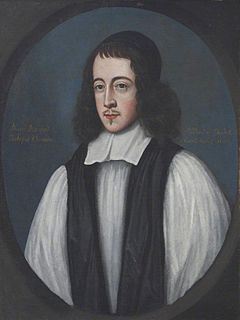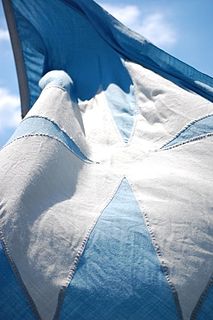
Wadham College is one of the constituent colleges of the University of Oxford in the United Kingdom. It is located in the centre of Oxford, at the intersection of Broad Street and Parks Road.
Samuel Parker was an English churchman, of strong Erastian views and a fierce opponent of Dissenters. His political position is often compared with that of Thomas Hobbes, but there are also clear differences; he was also called in his time a Latitudinarian, but this is not something on which modern scholars are agreed. During the reign of King James II he served as Bishop of Oxford, and was considered by James to be a moderate in his attitude to Catholics.

A turret clock or tower clock is a clock designed to be mounted high in the wall of a building, usually in a clock tower, in public buildings such as churches, university buildings, and town halls. As a public amenity to enable the community to tell the time, it has a large face visible from far away, and often a striking mechanism which rings bells upon the hours.

Nicholas Wadham (1531–1609) of Merryfield in the parish of Ilton, Somerset, and Edge in the parish of Branscombe, Devon, was a posthumous co-founder of Wadham College, Oxford, with his wife Dorothy Wadham who, outliving him, saw the project through to completion in her late old age. He was Sheriff of Somerset in 1585.

Dorothy Wadham was the foundress of Wadham College, Oxford. She has the distinction of being the first woman who was not a member of the Royal Family or titled aristocracy to found a college at Oxford or Cambridge. Her husband was Nicholas Wadham (1531-1609) of Merryfield in the parish of Ilton, Somerset and of Edge in the parish of Branscombe, Devon.

Sir Hugh Wyndham SL, of Silton, near Gillingham, Dorset, was an English Judge of the Common Pleas and a Baron of the Exchequer.

Sir John Trevelyan, 2nd Baronet of Nettlecombe, Somerset was a British landowner and Tory politician who sat in the English and British House of Commons between 1695 and 1722.

Walter Blandford was an English academic and bishop.

Joseph Knibb (1640–1711) was an English clockmaker of the Restoration era. According to author Herbert Cescinsky, a leading authority on English clocks, Knibb, "next to Tompion, must be regarded as the greatest horologist of his time."

Gilbert Ironside the younger was an English churchman and academic, Warden of Wadham College, Oxford, from 1667, Bishop of Bristol and Bishop of Hereford.

Wadham College Boat Club (WCBC) is the rowing club of Wadham College, Oxford, in Oxford, United Kingdom. The club's members are students and staff from Wadham College and Harris Manchester College. Founded some time before 1837, Wadham has had success both within Oxford and externally in regattas such as Henley Royal Regatta.

Benjamin Parsons Symons was an academic administrator at the University of Oxford in England.

John Wills D.D. was an English academic administrator at the University of Oxford.

William Smyth D.D. was an English academic administrator at the University of Oxford.
John Knibb (1650–1722) was an English clockmaker born in Claydon, Oxfordshire. He produced various clocks and watches including bracket clocks, lantern clocks, longcase clocks, and some wall-clocks, as well as building and maintaining several turret clocks. Even though his main market was catering to customers of modest means, he also dominated the higher-quality sector. Only six of Knibb's watches are known to survive.
Nicholas Lloyd (1630–1680) was an English cleric and academic, best known as a historical compiler for his Dictionarium Historicum.
John Caswell was an English mathematician who served as Savilian Professor of Astronomy at the University of Oxford from 1709 until his death.
Sir Humphrey Briggs, 4th Baronet, of Haughton, Shropshire, was an English Whig politician who sat in the English and British House of Commons between 1701 and 1727.

James Jennings (1670–1739) of Shiplake was an English landowner and Tory politician who sat in the House of Commons between 1710 and 1722.

William Bird or Byrd (1624–c.1691) was a 17th century English sculptor. He seems to have served Oxford University for many decades as their official mason. His most notable work is the covered arch linking the two sections of New College, Oxford, raised over the centre of the carriageway to allow laden haycarts to pass.















